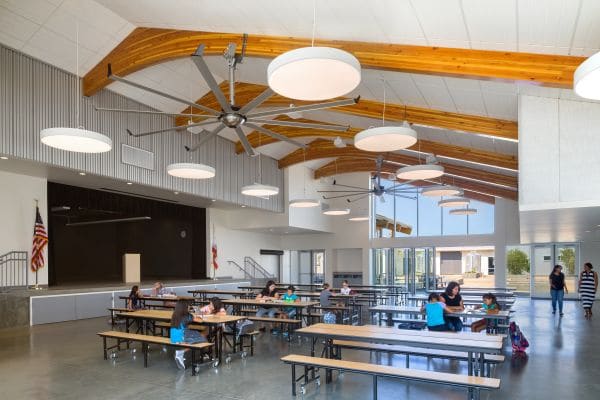Pre-K–12 education has become far more sophisticated over the years, and with that has come the need to re-evaluate how school design must evolve to keep up with the current curriculum.
There is a greater emphasis on student collaboration and creativity today, and technology has become a standard part of every learning environment.
Many elementary, middle, and high schools are looking toward incorporating a multipurpose hall into their facilities to allow for a wide variety of teaching and learning methods in one easily transformed space.
What Is a School Multipurpose Hall?
Simply put, a school multipurpose hall serves multiple program and functional purposes.
For example, while school gymnasiums have traditionally functioned as lunchrooms during inclement weather and as performance spaces, today’s students (and teaching models) demand more creativity in design.
There is ample opportunity to create a space that facilitates your school’s curriculum and your students’ needs.
What if you could divide your cafeteria into two smaller study spaces to be used before and after lunch?
Imagine opening a glass exterior wall of this space to the outdoors, allowing students to study or work on projects in the open air on good-weather days, and then rolling workstations and chairs to the perimeter to open the space up for a school dance that evening.
Why Consider a Multipurpose Hall?
Many traditional school designs include spaces that go unused for large portions of the day.
Gymnasiums, auditoriums, theaters, and large music rooms serve their purposes for a few hours and, on occasion, after hours when they’re used for events, but the rest of the time they often sit empty.
When unoccupied, these large spaces still consume resources, such as electricity and heat or air-conditioning.
A multipurpose hall can reduce utility costs, construction costs, and minimize space downtime.
And prior doubts about the feasibility and comfort of school multipurpose halls have been addressed with modern material and design solutions, making these spaces compelling and practical for today’s schools.
New Multipurpose Hall Designs and Features Allay Old Concerns
You’re likely very familiar with traditional moveable walls, dividers, and slide-out bleachers that have allowed schools to turn gyms and cafeterias into event spaces.
You’re probably even more familiar with the bad experiences that went along with them: the malfunctions, the noise, the manpower needed to transform a space, and the yards of extension cord required to make the space functional for a specific purpose or event.
Today’s multipurpose hall designs have met those concerns head-on:
- Move walls to move minds.
Operable walls, including glass walls that teachers can move with one hand or coiling doors that roll down from above with the push of a button, offer great sound insulation and built-in egress doors, and they secure in place easily, without having to call in maintenance staff
- Empower your students.
Gone are the awkward floor outlets that were tripping hazards, difficult to clean around and expensive to repair. They’ve been replaced with tables that roll and have charging stations built into them. At the end of the school day, simply roll the tables to the walls and plug them in to recharge their batteries for the next day.
- Tame the noise.
Large spaces can be noisy. A good design team will take that into consideration and include surface elements such as acoustic tiles, fabric-covered wall panels, or ceiling treatments that reduce excessive noise.
Even the shape of the room can work in favor of reducing reverberation. Angling walls so that they aren’t all at a 90-degree angle can help to dampen sound in the room. An experienced architect will work with an acoustic engineer to alleviate excessive noise in your multipurpose hall.
In addition to the above multipurpose hall design features, consider incorporating program-specific design trends.
If your school has a strong STEM focus, you might install gas and water connections at perimeter workstations to facilitate science experiments.
In a performing arts school, dual-purpose furnishings such as a portable stage and moveable audience seating can allow for an in-the-round theater performance one night and a debate team practice the next.
If PE class is going to be held in the space, an experienced design team will make sure that the flooring is appropriate and that the acoustics are considered to eliminate uncomfortable reverberation.
Choose the Right Multipurpose Hall Design for Your School
Your school is unlike any other. Therefore, your specific campus and your individual programs should be taken into consideration when designing your multipurpose hall.
We love the design challenges schools present and believe that a school multipurpose hall can be used to great effect, particularly in today’s innovative learning environments.
Over the years, we have designed multipurpose halls in a number of schools with a wide variety of programs.
Here are two examples:
At Portola High School in Irvine, California, we designed a multipurpose space that is similar to a student union you’d find on a college campus. With resilient floors, high ceilings, and a large, sliding glass wall that divides it from the learning commons, the space allows for many different functions, including studying, socializing, large group presentations, and other special events.
The K–8 Double Peak School in San Marcos, California, has a performing arts focus, so its multipurpose hall is acoustically sensitive, designed to direct performance sounds out to the audience. A ceiling treated with elegant wood helps to control the acoustics, as do strategically placed acoustic wall panels. These and other sophisticated yet practical finishes make the space feels more like a high-end theater than an elementary school performance space.
Taking the Next Step
Schools operate in a fast-paced world and must keep up with new technologies that help students and teachers succeed. Design is only great if it serves its intended purpose.
This information is courtesy of HMC Architects, a healthcare, education and civic architecture firm with a sustainable approach to design. Founded in 1940, they create high-performance architecture and interior design solutions that not only wow and withstand, but also enrich people’s lives and serve the greater good, www.hmcarchitects.com.















